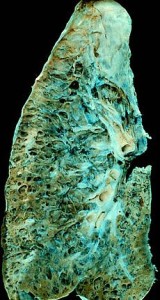Visit and Join the WeHeal Interstitial Lung Disease Community
For more information, see: MayoClinic | Wikipedia

Visit and Join the WeHeal Interstitial Lung Disease Community
For more information, see: MayoClinic | Wikipedia

Interstitial (in-tur-STISH-ul) lung disease describes a large group of disorders characterized by progressive scarring of the lung tissue between and supporting the air sacs. The scarring associated with interstitial lung disease may cause progressive lung stiffness, eventually affecting your ability to breathe and get enough oxygen into your bloodstream.
Interstitial lung disease may be broadly categorized into known and unknown causes. Common known causes include autoimmune or rheumatologic diseases, occupational and organic exposures, medications, and radiation. Interstitial lung disease of unknown cause is predominated by idiopathic pulmonary fibrosis, a specific and progressive fibrotic lung disease, followed by the idiopathic interstitial pneumonias, such as nonspecific interstitial pneumonia (NSIP), and sarcoidosis.
Once lung scarring occurs, it’s generally irreversible. Medications may slow the damage of interstitial lung disease, but many people never regain full use of their lungs. Lung transplant is an option for some people who have worsening interstitial lung disease despite treatment.
Visit and Join the WeHeal Interstitial Lung Disease Community
For more information, see: MayoClinic | Wikipedia
WeHeal is very grateful to our valued sources of information which include Wikipedia, WebMD, ClinicalTrials.gov, Cancer.gov, Infoplease, and the US CDC (Center for Disease Control).